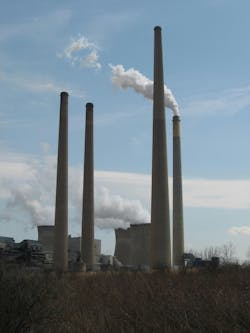Kiewit, GE Vernova Converting Pennsylvania Coal Plant to 4.5-GW Gas-Fired Electricity for Data Centers
Northern Virginia is the acknowledged king when it comes to data centers in the U.S., but a Keystone rival up north of the commonwealth is investing big to challenge that crown maybe someday.
Pennsylvania’s one-time largest coal-burning power plant is being converted into an even more massive, 3,200-acre natural gas-powered data center campus slated for operation in two years. Homer City Redevelopment and engineering and construction contractor Kiewit Power Constructors are collaborating on the project.
Historically, the old coal-fired Homer City plant contained three units totaling about 2 GW in generation capacity. Tough economics for coal-fired power, however, led to two bankruptcies and the plant being shut down two years ago.
The new, gas-fired version will emit less than half of the carbon emissions of the coal units, while also delivering a planned 4.5 GW of power to support artificial intelligence (AI)-driven data centers. The initial investment to build the Homer City gas-fired data center complex is estimated at close to $10 billion, with project financing led by Knighthead Capital Management.
“This project will honor Homer City’s place in the proud history of Pennsylvania energy generation, while accelerating the state and local community’s ability to meet the needs of a rapidly shifting energy landscape,” said William Wexler, CEO of Homer City Redevelopment, said in a statement. “Alongside our best-in-class partners, we have been working tirelessly to ensure that Homer City’s transformation can happen as quickly and seamlessly as possible. Further, we are fully committed to maximizing the unprecedented level of economic opportunity this project represents not just for Indiana County, but for all of Pennsylvania and the Mid-Atlantic region of the country.”
Some of the original plant was demolished when the coal-fired units were shut down, yet much of the infrastructure remains, including transmission interconnection to the PJM and NYISO regional grids. GE Vernova will supply seven 7HA.02 hydrogen-enabled, gas-fired turbines, with first deliveries of those units by 2026.
Construction will begin later this year and is expected to be completed and operational by 2027.
Location of the Homer City redeveloped power plant also makes regional sense in terms of the fuel needed. Pennsylvania sits atop the prolific Marcellus Shale gas play.
"Kiewit is excited to help advance what is poised to become the nation’s largest natural gas-powered plant,” said Dave Flicklinger, executive vice president at Kiewit Power Constructors Co. “We’ve been pleased by how quickly all parties have worked to make this project shovel-ready, all while holding firm to the highest standards of safety and quality – principles we live by at Kiewit. We look forward to continuing our tradition of collaboration and moving with purpose as we enter the next phase on the ground."
The inevitable demand curve driven upward by AI, reshoring of manufacturing and electrification expansion for commercial and industrial customers may lead to the biggest growth in electricity demand in decades. Some 50 GWs of new generation may be required to meet expected new AI load by the start of the 2030s.
Virginia alone has perhaps 500 or more data centers within its boundaries. The state’s dominance in this sector continues but grid congestion caused by this build-up is pushing many data center developers to examine sites around the country.
Pennsylvania currently holds less than one-fifth of the data center capacity of Virginia, while northern California remains a popular site for new facilities. Proximity to fiber lines has played the biggest role in data center location, but availability of energy is accelerating the search outward from Virginia.
Meeting that need is changing the power dynamic of the commercial and industrial energy transition. Power equipment manufacturer GE Vernova, for instance, is forging new partnerships with numerous data center and tech entities such as Amazon Web Services.
GE Vernova’s latest announced deal is with the Massachusetts Institute of Technology. This alliance with MIT will focus on research and talent development in the energy sector.
GE Vernova will provide $50 million over five years to fund research initiatives, student fellowships, and internships, as well as educational and professional development programs for GE Vernova leaders. The partnership, which begins in September, will be managed through MIT’s Office of Strategy, bringing together faculty, researchers, and students to address some of the most pressing challenges in energy and climate technology.
“This alliance embodies the spirit of the MIT Climate Project—combining cutting-edge research, a shared drive to tackle today’s toughest energy challenges, and a deep sense of optimism about what we can achieve together,” said Sally Kornbluth, President of MIT. “With the combined strengths of MIT and GE Vernova, we have a unique opportunity to make transformative progress in the flagship areas of electrification, decarbonization, and renewables acceleration.”
GE Vernova and MIT will launch research projects around the future demand of electrification in the industrial sector, decarbonizing the power sector and optimizing renewable energy development.
Data Centers and Microgrids
Learn More at the Microgrid Knowledge Conference in Dallas
Only Two Weeks Away! Register soon







